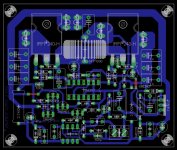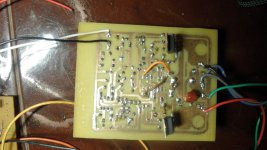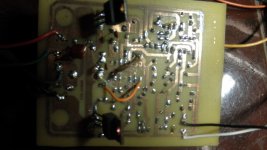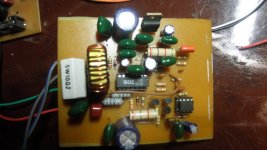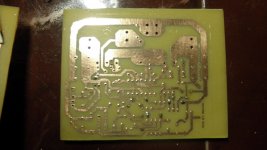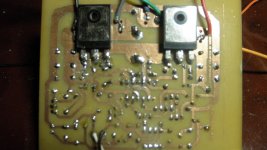hi lycanlk pls can you post your single sided board or email me the plans for your single sided circuit . many thanks in advance . stewin stevekamala@yahoo.com
I will send you, once I correct all errors on my PCB..
hi lycanlk do you have on imput noise like that found on the radio when it's tuned ? i made this amp whit the original PCB i use T130-2 core from micrometals wounded whit litzwire for the output mosfet i use IRFP260 nothing heats up i use +/-29V but i get this radio like noise on the imput i use an MP3 player (sony) it sounds good really good but when i touch the MP3 (it has metal body) i get radio like noise in spekers...allso if i connect the amp to the sound card off my computer i get real loud noises please help (sorry for my english)
Dear Andrew,
I followed the attached schematic.. but its is almost the same original one if you can carefully follow it.. I used BC557 instead of 2N4501.. but I prefer 2N5401 ! I bunt all my 5401s burnt out in the test by my mistake. LOL
Output coil is getting hot a bit but can touchable.. want to check it with high voltage.. I will let you know. I wounded it myself just to test the amp so its not accurate at all.. some experts on this subject might help us in future..
regards,
Lycanlk
I followed the attached schematic.. but its is almost the same original one if you can carefully follow it.. I used BC557 instead of 2N4501.. but I prefer 2N5401 ! I bunt all my 5401s burnt out in the test by my mistake. LOL
Output coil is getting hot a bit but can touchable.. want to check it with high voltage.. I will let you know. I wounded it myself just to test the amp so its not accurate at all.. some experts on this subject might help us in future..
regards,
Lycanlk
Attachments
hi lycanlk do you have on imput noise like that found on the radio when it's tuned ? i made this amp whit the original PCB i use T130-2 core from micrometals wounded whit litzwire for the output mosfet i use IRFP260 nothing heats up i use +/-29V but i get this radio like noise on the imput i use an MP3 player (sony) it sounds good really good but when i touch the MP3 (it has metal body) i get radio like noise in spekers...allso if i connect the amp to the sound card off my computer i get real loud noises please help (sorry for my english)
I cant give an exact answer for your request.. but I always use my computer sound card to test amps as a reference.. may be a bad habit but i'm used to..
Anyway once I bunt my main board due to leakage of high frequency though the cable from sound card so do not plug it to your PC unless you are sure about the amp.. (for safety)
check your copper paths and lines on PCB..and insulators there you'll find fault.. the amp should work fine with PC sound card !
you PC turned off as a safety function..otherwise your processor or mainboard is already gone and the noise you get because of the same fault I guess (high frequency leakage)
regards,
Lycanlk
hi lycanik
greetings thanks for your reply all improvements can be read at
foros de electronica written in spanish use mozilla firefox and install addon
FOX lingo to translate pages please when you correct pcb can you send me
pcb pattern e mail to lebonandrea@yahoo.com
thanking you
andrew lebon
greetings thanks for your reply all improvements can be read at
foros de electronica written in spanish use mozilla firefox and install addon
FOX lingo to translate pages please when you correct pcb can you send me
pcb pattern e mail to lebonandrea@yahoo.com
thanking you
andrew lebon
could it be because i used for feedback cap 330p ceramic..instead off mica (or polyester)? i heard that ceramic caps do not supress the high frecvencies that good (an it feeds the amp with high frec. on imput)
Dear Andrewlebon,
I made a mistake by winding the output inductor on a iron core.. That is the reason why it gets hot. because it filters high frequencies.. I rewound it on a ferrite core.. Its so cool now 🙂
And the amp has a problem when I connect it to PC. high frequency noise is coming out.. when It plays.. sounds like "ZZZZZZZZZZZZZ" hope no issues with other players..its coming only by PC.. and of cause no issues for subwoofers. It produces amazing bass.. very deep bass without any trouble! I will post pictures of my amp very soon (have a prob with my camera)
I redesigned my PCB. This time no issues.. works fine! anyway you have the original layout now. but if you need it let me know Ill send it.
regards,
Lycanlk
I made a mistake by winding the output inductor on a iron core.. That is the reason why it gets hot. because it filters high frequencies.. I rewound it on a ferrite core.. Its so cool now 🙂
And the amp has a problem when I connect it to PC. high frequency noise is coming out.. when It plays.. sounds like "ZZZZZZZZZZZZZ" hope no issues with other players..its coming only by PC.. and of cause no issues for subwoofers. It produces amazing bass.. very deep bass without any trouble! I will post pictures of my amp very soon (have a prob with my camera)
I redesigned my PCB. This time no issues.. works fine! anyway you have the original layout now. but if you need it let me know Ill send it.
regards,
Lycanlk
Attachments
I made a mistake by winding the output inductor on a iron core.. That is the reason why it gets hot. because it filters high frequencies.. I rewound it on a ferrite core.. Its so cool now 🙂
And the amp has a problem when I connect it to PC. high frequency noise is coming out.. when It plays.. sounds like "ZZZZZZZZZZZZZ" hope no issues with other players..its coming only by PC.. and of cause no issues for subwoofers. It produces amazing bass.. very deep bass without any trouble! I will post pictures of my amp very soon (have a prob with my camera)
I redesigned my PCB. This time no issues.. works fine! anyway you have the original layout now. but if you need it let me know Ill send it.
regards,
Lycanlk
The intention of putting together the heatsink the TIP31C is that it suppresses the release of HF. This PCB is very poor compared with that of the author.
Greetings!
The intention of putting together the heatsink the TIP31C is that it suppresses the release of HF. This PCB is very poor compared with that of the author.
Greetings!
Well.. I dont understand the reason why the noise come out just by the design but not with any other reason.. My design is not for professionals. I designed it to make easily by myself or yourself.. I made the PCB myself just by ironing a printed paper. And My idea was to mount the PCB to a ground plate easily (plate=heat sink)..
You can mount TIP31c(I used TIP41c) to the same plate just by bending down parallel to the PCB like main FETs.. I dont think that the problem will be solved .. because I'm not the only one who got the noise problem.. I doubt about the output inductor yet. If there's someone who has got to work without noise, could you help us please !
regards,
Lycanlk
hi lycanic
greetings thanks for all the info please i will try your pcb tracks are easy to solder
please can you send pcb pattern till what voltage have you tested it waitig for you
thanking you
andrew
greetings thanks for all the info please i will try your pcb tracks are easy to solder
please can you send pcb pattern till what voltage have you tested it waitig for you
thanking you
andrew
The noise problem is persistent, it is true. The amplifier has a gain a little high.
In my case, I used a small preamp in the audio input to the amplifier, thereby reducing noise. Other mishaps I've noticed is that putting the potentiometer to the maximum, you hear a lot of noise to the output. Testing various inducers, some with protective casing, I managed to eliminate noise as possible.
Another cause may be the source of audio, in my case using a CD player, noise was heard at the exit was too much. Connecting a DVD player, the sound is also gone.
Recommendations for the noise is minimal and the know: A good ground plane, input and output connectors isolated from chassis, audio cable with copper mesh, well-organized internal connections, signal cables away weak power supply ...
Well, to name a few tips.
Greetings!
In my case, I used a small preamp in the audio input to the amplifier, thereby reducing noise. Other mishaps I've noticed is that putting the potentiometer to the maximum, you hear a lot of noise to the output. Testing various inducers, some with protective casing, I managed to eliminate noise as possible.
Another cause may be the source of audio, in my case using a CD player, noise was heard at the exit was too much. Connecting a DVD player, the sound is also gone.
Recommendations for the noise is minimal and the know: A good ground plane, input and output connectors isolated from chassis, audio cable with copper mesh, well-organized internal connections, signal cables away weak power supply ...
Well, to name a few tips.
Greetings!
Tacatomon, Appreciate your comment !
Andrew, I tested the amp with +/-40v supply .. even at full volume It works without a heatsink. FETs are touchable. I used IRFP250 this time and I haven't got a supply beyond +/-40 for further testing.. hope works fine with high voltage too. but be aware of your component's voltage rating.
The amp is super efficient ! good bass ! but the only issue is noise. Once I could correct it. Amp is ready to go. Anyway I recommend this amp as a subwoofer amplifier with a low pass filter for the best performance !
regards,
Lycanlk
Andrew, I tested the amp with +/-40v supply .. even at full volume It works without a heatsink. FETs are touchable. I used IRFP250 this time and I haven't got a supply beyond +/-40 for further testing.. hope works fine with high voltage too. but be aware of your component's voltage rating.
The amp is super efficient ! good bass ! but the only issue is noise. Once I could correct it. Amp is ready to go. Anyway I recommend this amp as a subwoofer amplifier with a low pass filter for the best performance !
regards,
Lycanlk
You need way more tension on the wire when winding the output inductor.
of cause yes. This is a dummy inductor.. the one I'm planning to use for this is smaller than this too and I didn't receive it yet. Thanks for watching it carefully.
regards,
Lycanlk
hi lycanik
greetings can you send pcb pattern please
will try it on your pcb pattern if you send me
thanking you
andrew
greetings can you send pcb pattern please
will try it on your pcb pattern if you send me
thanking you
andrew
- Home
- Amplifiers
- Class D
- UCD 25 watts to 1200 watts using 2 mosfets

